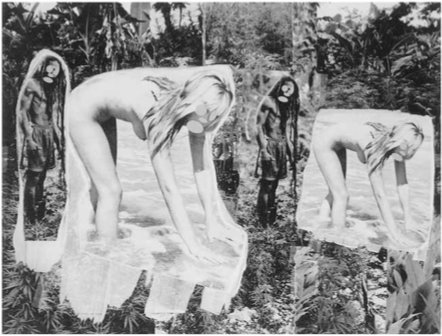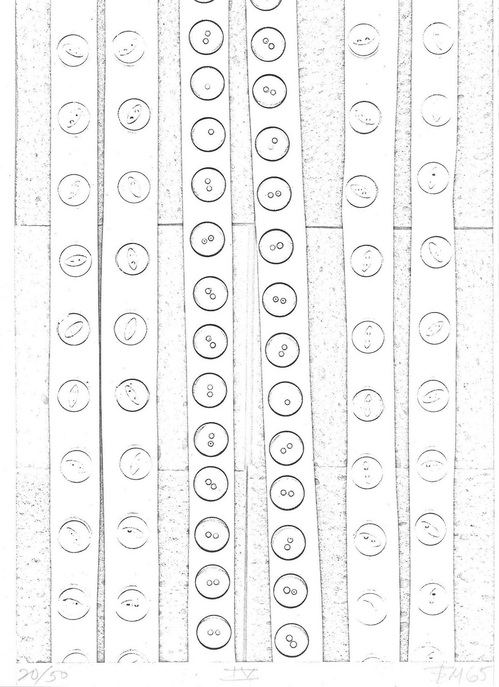
Illustration from Ed Meneeley’s Tender Buttons, 1964
You may know Edward Meneeley from such art historical blog posts as, “The guy who published the subscription art slide library and newsletter which Rauschenberg refused to allow to reproduce Short Circuit in 1962 because of the agreement Rauschenberg and Johns had come to after their messy breakup,” and “The guy who told me how Johns really transformed an erased de Kooning drawing into Erased De Kooning Drawing,” and “The guy who was hooking up with at least Bob at the time, yow, small world.”
But he also turns out to be one of the first artists to use the then-new technology of photocopying to make prints. Starting in 1964, when a friend took him to IBM’s offices, where he saw a copy machine for the first time.
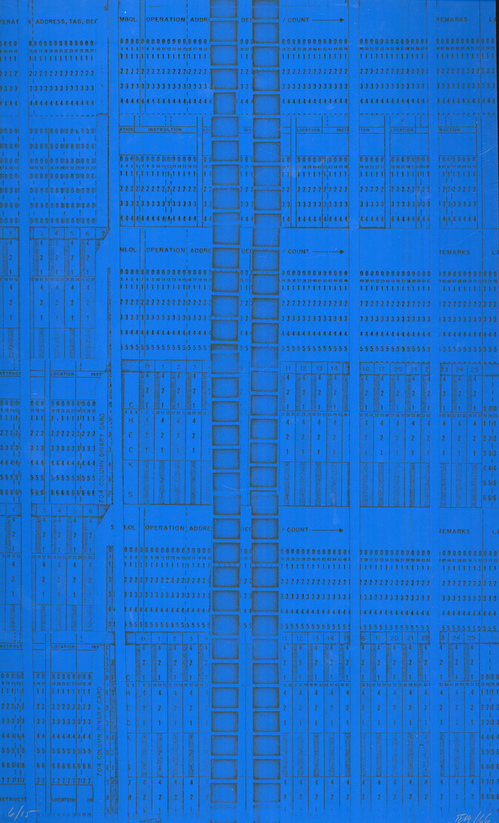
Edward Meneeley, IBM Drawings
Meneeley made three print portfolios using a photocopier: Tender Buttons (1965) [top] was a suite of illustrations for Gertrude Stein’s work of the same name. IBM Drawings (1966) was an exploration of the medium and its context, abstract, collaged images composed from computer tapes and other office ephemera that Meneeley found at hand. There was also a hairy, photocopied butt, presumably the artist’s.
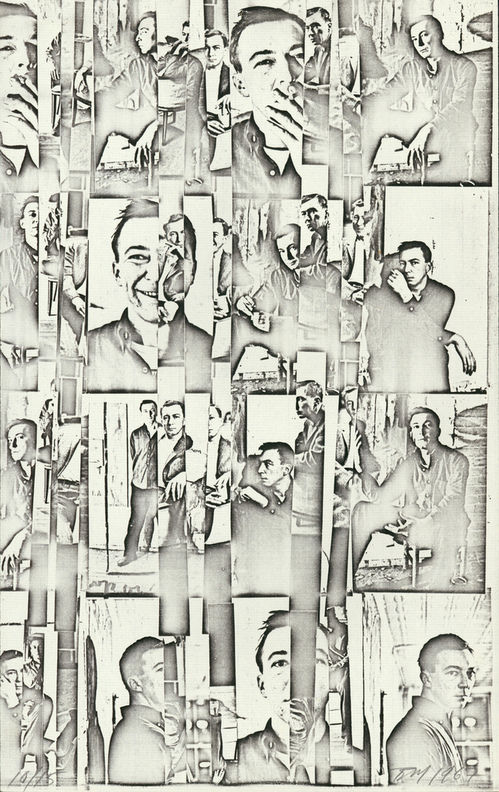
And then in 1968, the year Seth Siegelaub instigated his highly influential, photocopied-book-as-exhibition project, The Xerox Book, Meneeley made Portraits: People and Objects, which included a reassembled photo collage portrait of his friend Jasper Johns. But where Siegelaub and his crew were skewing to the conceptual aspects of copying, Meneeley was very attuned to the technical subtleties of photostatic reproduction, which he interpreted as a unique printmaking medium, an updated form of lithography.
Great stuff.
Edward Meneeley and the advent of the electrostatic artist’s print [rectoversoblog, which has many more images, not just the 2nd & 3rd images above]
Gig: The Contemporary Artists’ Books Conference, Friday 9/28, 2PM

I am stoked and a bit daunted to be participating in a session on appropriation at this year’s Contemporary Artists’ Books Conference. It will be this coming Friday at PS1, as part of the NY Art Book Fair, and will take place in the Performance Dome:
2:00-3:30 pm
Appropriation and Intellectual Property
Debates on the the legal complexity of appropriated imagery have resurfaced in light of a recent lawsuit between artist Richard Prince and photographer Patrick Cariou. Artists Greg Allen and Eric Doeringer and lawyer Sergio Muñoz Sarmiento will discuss notions of “fair use” and “transformation” with our digital culture, as well as the question of how copyright law should adapt to rapidly evolving artistic practices and whether copyright law might constitute a medium in and of itself. Organized and moderated by Stephen Bury.
I hope you can come to the Fair, of course, because it is amazing. And while you’re there, I hope you’ll come by the session. It’s a big dome, and it’ll feel even bigger if it’s empty.
CABC Conference Sessions [nyartbookfair]
image: from DJ Francois and Juan Atkins’ performance during the MoMA PS1 Kraftwerk Festival, via timeout
Shrapnel Bench By BarberOsgerby
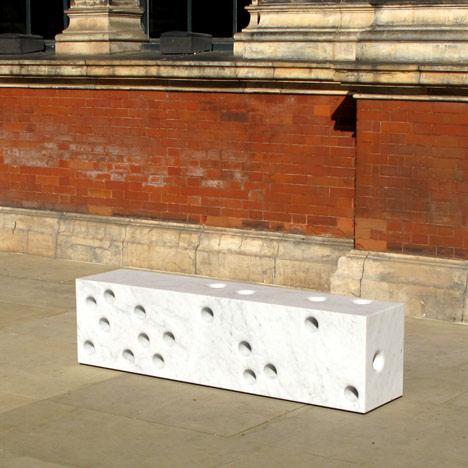
Speaking of violence and sculptural street furniture, the design team of Edward Barber and Jay Osgerby and Tor Studios made one of a series of commissioned benches for the Victoria & Albert Museum during the London Design Festival. It is an elegantly pockmarked block of Carrara marble.
They were inspired by shrapnel marks left in the V&A museum’s western facade after the Second World War. “It’s something that always fascinated me and Ed on the way from South Kensington tube up to the Royal College when we were students, and so when this project came up we thought it was a nice way to reference that,” explained Jay Osgerby at the opening.
Indeed, the splash page for the duo’s website is currently an image of the shrapnel marks.
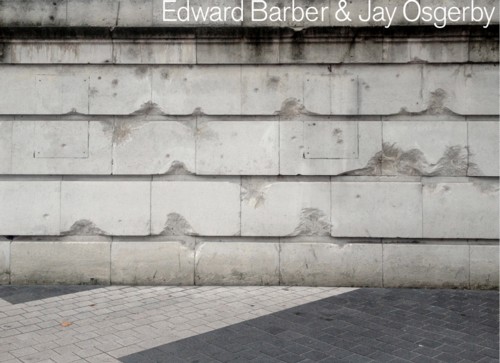
Which, of course, immediately brings to mind the facade of JP Morgan’s former headquarters, 23 Wall Street. The building was damaged by an explosion on Sept. 16, 1920, that was believed to be carried out by Italian anarchists. A donkey cart laden with 100 lbs of dynamite and 500 pounds of cast-iron window sash counterweights exploded at 12:01, killing 38 and injuring more than 143 people on the street and in the building.
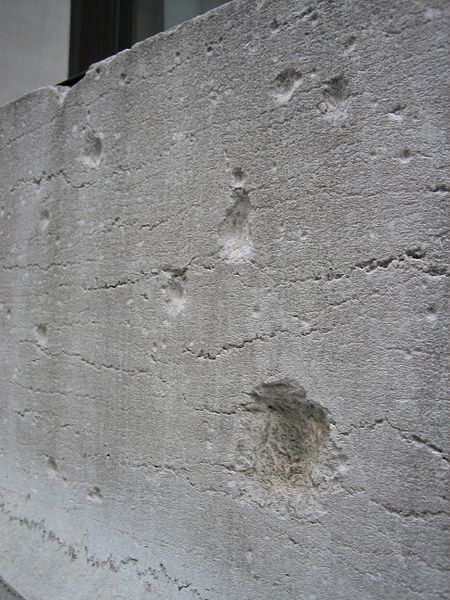
Morgan refused to repair the shrapnel marks, which are still visible on the pink marble Wall St. facade to this day. The building, long vacant, is currently being marketed as a retail site, perhaps for a department or Apple store.
Bench Years by Established & Sons at the V&A museum [dezeen]
Domestic Objects
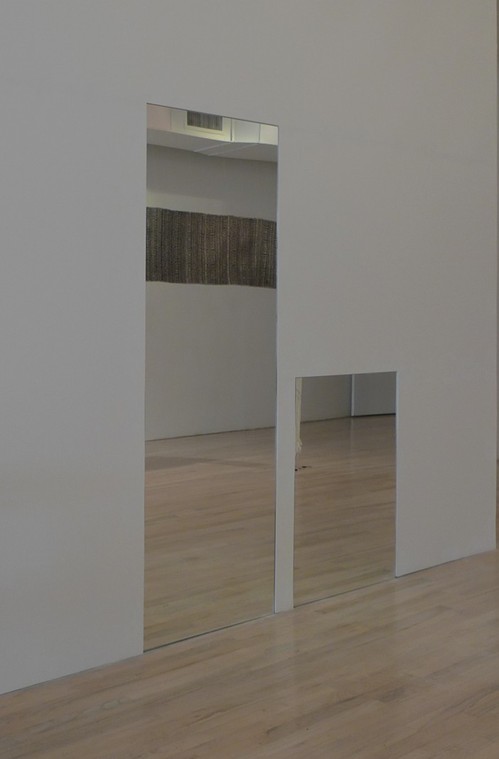
“Untitled” (Orpheus, Twice), 2012, Bridge Gallery installation
From the gallery website for “Domestic Objects,”:
For “Untitled” (Orpheus, Twice), 2012, Greg Allen alters Felix Gonzalez-Torres’ elegiac 1991 work, cutting one of the pair of identical, adult-sized mirrors down to a toddler’s height. In Gonzalez-Torres’ original conception, the work’s evocation of the musician of Greek myth who travels to Hades in hope of bringing his beloved Eurydice back from the dead, has been understood as a reference to the artist’s own partner Ross Laycock, who had just died from AIDS-related illnesses.
Former MoMA curator Rob Storr has also noted a formal resonance between Felix’s piece and Jean Cocteau’s 1950 film version of Orpheus, set in postwar France, in which a bedroom mirror becomes the mourning hero’s gateway to the underworld.
By transmuting the twinned mirrors’ allusions from lovers to parent and child, Allen’s simple gesture renews and expands the senses of personal loss and political outrage of Gonzalez-Torres’ original. By faithfully preserving the rest of the work, including the title, “Untitled” (Orpheus, Twice) marks the ground traversed in the intervening decades; from a fight for survival against homophobia and the AIDS epidemic to marriage equality and gay dads. Changes Felix might have taken measure of himself, if only he were still here.
Domestic Objects is on view at Bridge Gallery, 98 Orchard Street below Delancey, through Oct. 18 [bridgegalleryny]
Untitled (NYPD)
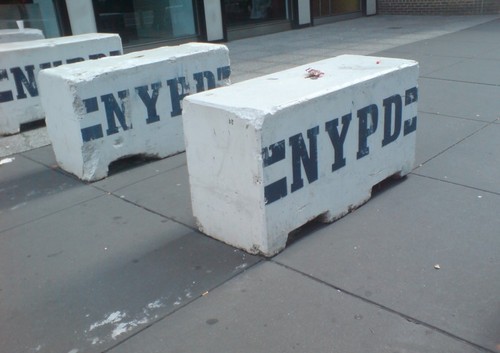
It’s UN Season in New York, and the streets are filled with people enjoying the sun, and squeezing through these flat-out gorgeous NYPD barriers. Seriously, I mean, Tony Smith, Donald Judd, Richard Serra, Beverly Pepper, Anselm Kiefer, Janine Antoni, Scott Burton, Robert Gober–you see where I’m going with this? I mean, Rachel Harrison–I’d love to make a Rachel Harrison-style version of these. That would be awesome. and so much more manageable, too.
Oh, look, I was right:
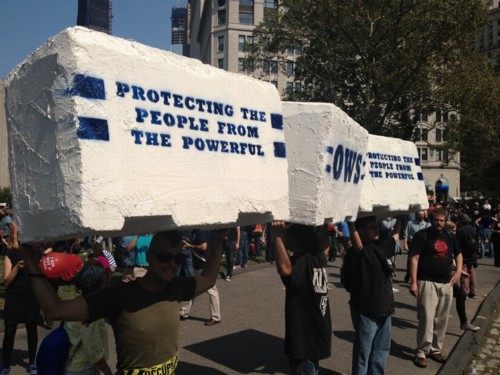
Occupy protestors on Sept. 17th in Battery Park, as covered by Bucky Turco at Animal New York
So the next thing would be a Cow Parade-style celebration across the whole city. These barriers could become a vibrant platform for artists the world over, and highly collectible, too. Munny dolls-meets-street security furniture.
I. Am. On it.
The Secret Ingredient Turned Out To Be Infringiness
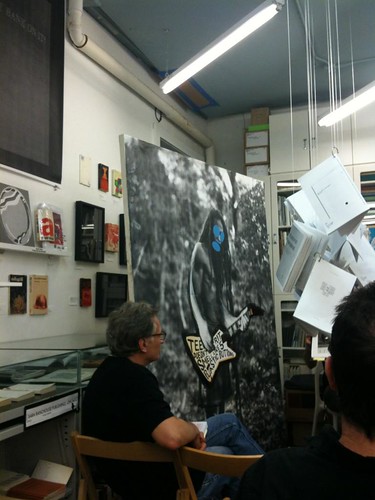
Well that cat’s out of the bag.
Joy Garnett posted audio from the Richard Prince Canal Zone discussion she, Chris Habib and I had Saturday night at Printed Matter. It’s available for streaming or download at the Internet Archive. OR for remixing, autotuning, and stop-action animating, whatever you want, since artpanelsjustwanttobefree it’s public domain.
It clocks in at almost an hour and a half, and who knows what you’ll find in there. I was too high on life and drunk on power–I was running the projector, too– to really remember what was said. Though I do remember something about megayachts, Perry Mason vs Law & Order; and wishing you were Rasta and/or punk. So really, something for everyone.
Many thanks to Chris and Joy, to Keith and Max and the PM Crew, and especially to the awesome and engaged audience. We’ll do it again for either the damages hearing or the Supreme Court phase.
Cariou v. Prince Meets Iron Chef, Discussion & Crit at Printed Matter, NYC [archive.org]
Joy Garnett’s flickr photoset clearly reveals I have no veto power over her photos of me [flickr]
Two Gigs: Saturday 9/22 @Printed Matter, Friday 9/28 @NYABF
I’m really stoked to be participating in two events in New York in the next few days. Please come if you’re in town, and pass the word.
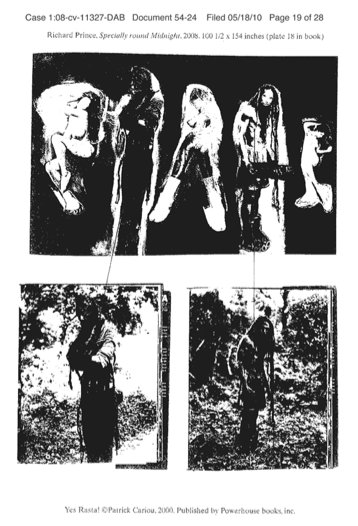
crappy photocopy court exhibit of Specially Round Midnight and the Patrick Cariou photos that went into it
The first is at Printed Matter this coming Saturday evening, Sept. 22, from 6-7:30PM. It should be a hoot:
The ongoing Cariou v. Prince trial have presented a high-stakes platform for debating copyright, appropriation, fair-use and artists’ rights. One thing that’s been oddly missing from the discussion, though, is the art itself.
Printed Matter will host a raucous crit of Richard Prince’s little-seen but much-contested Canal Zone paintings, culminating in an open-forum, Iron Chef-style evaluation of each artwork in terms of content, aesthetics, and infringiness.
The Ocean Club, 2007
Using bootleg copies of Prince’s banned exhibition catalogue and excerpts from the artist’s own sworn deposition testimony which were never entered into evidence in court, panelists Joy Garnett, Greg Allen, and Chris Habib will take a closer, critical look at Prince’s paintings and practice in an art historical context.
Joy Garnett is an artist and writer in Brooklyn, NY. She is also the founder of the blog NEWsgrist (where spin is art).
Greg Allen has been writing about the creative process at greg.org: the making of, since 2001. He published Canal Zone Richard Prince YES RASTA: Selected Court Documents from Cariou v. Prince et al. in 2011.
Chris Habib is an artist and the curator of HELP/LESS, which runs through Sept. 29th at Printed Matter.
And then next Friday, Sept 28 at 2-3:30, I’ll be speaking at the Contemporary Artist Book Conference as part of the NY Art Book Fair at PS1. The session, led by Stephen Bury, will be on the limits, excesses, and future of appropriation and copyright law. Artist Eric Doeringer and artist/lawyer Sergio Muñoz Sarmiento will also speak. It should be awesome. If you’re at the Fair, definitely come join us in the Dome.
Gosh And Golly, Those Aren’t Swear Words
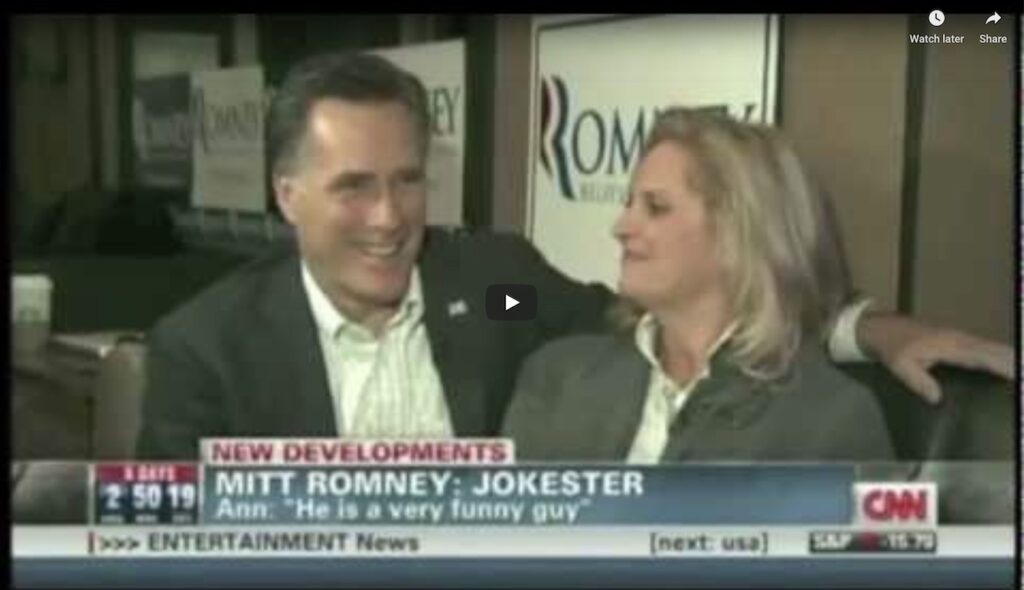
Three words: Oh my heck. [dissociativepress.com via @petcobra]
Malcolm X, Black Muslim, Sforzian
Maurice Berger has a fascinating post on the NY Times Lens blog about Malcolm X’s sophisticated use of the media, particularly photography, and particularly the antagonistic white/mainstream media, to reach out to potential black constituents.
Exhibit 1–actually and unfortunately, it’s the only photo in the post–is Robert Flora’s 1963 photo for UPI, the caption for which:
Malcolm X, the nation’s number two black Muslim leader, reads a story about the Muslims in a national magazine as he sits in court with other Muslims awaiting verdict of an all-white jury deliberating the face of 14 Muslims accused of criminal assault against Los Angeles police officers.
manages to mention Muslims four times in once sentence. Impressive.
As Berger notes,
The men in the picture are focused on articles about the Nation of Islam. The Life magazine story that engrosses Malcolm, for example, was typical of the derisive coverage of the Black Muslims in the mainstream press: “The White Devil’s Day Is Almost Over: Black Muslim’s Cry Grows Louder,” screams its headline.
It only proves Berger’s astute point to point it out, but Malcolm X is anything but engrossed; he’s holding the magazine up for the photographer. Even if he were able to read at that angle–he seems to actually be looking at the paper in the hands of the man to his left–a quick search of the actual LIFE Magazine article shows there is nothing to read. The other half of the spread is a full-page shot of Elijah Muhammad, by Gordon Parks. [The cover line for the feature reads, “A Negro Photographer Shoots From The Inside – THE BLACK MUSLIMS.”]
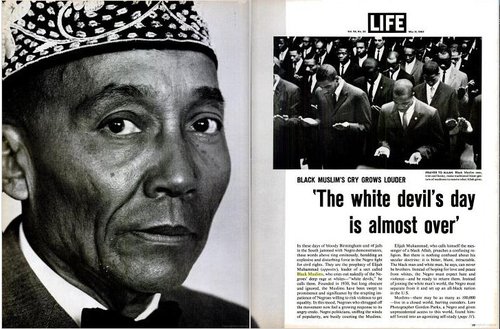
Which, it turns out the man to Malcolm’s right is also reading. Berger doesn’t mention the headline on the paper the guy behind is very much not reading: “Seven Unarmed Negroes Shot in Cold Blood by Los Angeles Police.”
Which turns out to be Muhammad Speaks, the NOI’s newspaper. The first Google result for it appears, perfectly, in Gordon Parks’ LIFE feature. Parks was following Malcolm at the trial. Which only underscores the newspaper’s–and eventually, the magazine’s–function as a prop, intended not [necessarily, nor not solely] for the jury, but for the photographers covering the trial.
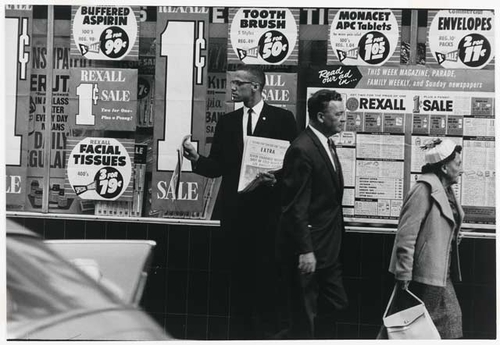
If there’s any doubt of the paper’s message-within-a-photo, here are other shots by Parks, of Malcolm X selling the paper,
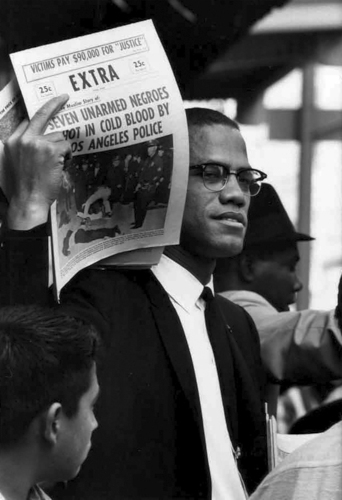
and holding it up at a Black Muslim speech in Harlem. [images via Gordon Parks Foundation]
I don’t know why it has literally never occurred to me, but Berger’s account of the vehemence and derision Malcolm X received from the white establishment, and the extraordinary calculation and discipline with which Malcolm carried and presented himself, and his unfailingly calm, cool, self-assured and buttoned-down image, really jumps out at me now. Especially when it’s coupled with the terms Muslims and Black Muslims, which get repeated in the press of the day with such divisive, alienating force.
As if that was the absolute worst, scariest thing you could call someone. In 1963. In 2012, meanwhile, it’s settled into a niche birther conspiracy.

Malcolm X as Visual Strategist [nyt lens blog]
Good Mourning
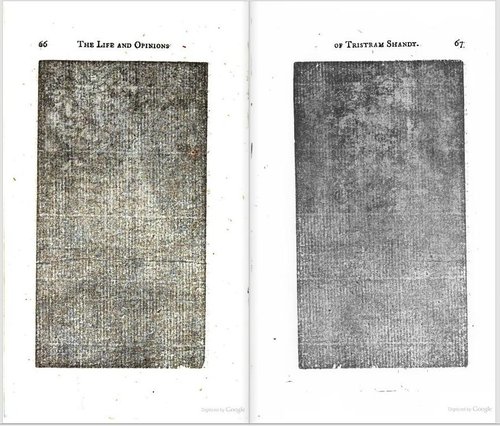
I knew vaguely of Laurence Sterne’s The life and opinions of Tristram Shandy, Gentleman‘s importance, and I did see Michael Winterbottom’s wild 2005 film adaptation, but I’ve never read the book itself. So HOLY SMOKES, PEOPLE, Mourning Pages!
Sterne wrote and designed Tristram Shandy [1759] not just as a story, but very much as a reading experience. Which is why the death of the parson Yorick in Vol. I is followed by a page printed solid black. It’s usually called [by Shandyheads] The Black Page.
But as Duke comp lit PhD candidate/blogger Whitney explains, it’s most typically called a mourning page, and Tristram Shandy is the first time a mourning page was deployed in fictional writing.
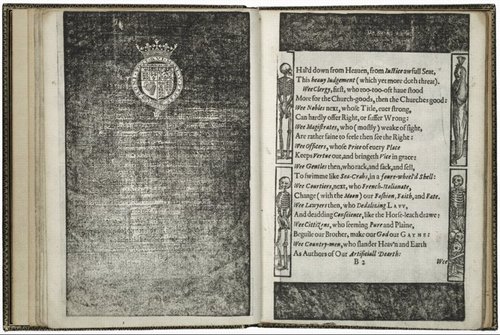
Lachrymae, 1613, Joshua Sylvester, image via folger.edu
Whitney has pulled together an incredible assortment of mourning pages, which usually appeared at the beginning of a book as a memorial to a deceased king or the author’s patron.
They sometimes had text or a crest, or designs or illustrations, but a solid monochrome monolith of black was not unheard of. Except, of course, by me.
In 2009 the Laurence Sterne Trust organized an exhibition titled, The Black Page, for which they solicited 73 artists to create their own interpretation of the black page. The artists ranged from John Baldessari to Kenneth Goldsmith to Lemony Snicket.
I think that by now, three+ years later, the artificial suspense has played out, and the Trust can go ahead and reveal the identities of the artists of each work on their little blog.
Diapsalmata: Tristram Shandy & the art of black mourning pages [whitneyannetrettien via bibliodyssey, I think]
The Black Page [blackpage73.blogspot.com]
Blurromney

It’s not like this hasn’t happened before. I remember one time, in the late 1990s, at the Stedelijk, being transfixed by a series of videos Gabriel Orozco had made. I was already very interested in his work for a while, but there was something about those videos.
Orozco had basically edited them in-camera while walking around New York and Amsterdam, and they had this wonderful, stream-of-perception-like quality, almost as close as you could get, it seemed, to the artist’s own visual experience.
It basically changed the way I see. He was making off-hand, formal connections between things. There were a lot of circles, for example. Cups, bicycle tires, stickers on windows, bar coasters, bubbles. And once the connection had been made, it became impossible not to think of Orozco every time I saw circles in the world. There was much in Gabriel’s early work that was similarly, quietly powerful in the way it awoke you [me] to nuances of seeing and understanding the world around you [me].
Which is not quite the point here, except that just as with Orozco and his circles, it’s now basically impossible for me to see a blur and not think of Gerhard Richter. And not wonder, for example, how awesome it might be as a painting.1
Like–oh, I’ll just pick any random thing–a still from the damning video of Mitt Romney speaking unguarded Republican truthiness at a private fundraiser in Florida, which was shot and disseminated anonymously for weeks before Mother Jones picked it up today. And attempted to protect the video’s source–by blurring the footage. Except for Romney himself, whose face is unblurred, and the Corinthian capital behind him. Hey look, a circle.
1 The answer, of course, is it’d look awesome. Just look at those colors. The different segments of the video have different blurs, too. I think this one’s especially velvety. Chinese Paint Mill certainly has their work cut out for them.
Team Jeffrey
I still have not seen any news emerge from the special MOCA trustees’ meeting held last Tuesday, but I assume it went swimmingly.
Because on Wednesday night, director Jeffrey Deitch was all smiles and business as usual, headlining Baguettemania, a pop-up store-in-store/booksigning at Maxfield to commemorate the 15th anniversary of Fendi’s iconic It Bag.
There was a whole crew of MOCA folks in attendance, including MOCA publicist Lyn Winter and leading board members Steven Mnuchin and Maria Bell. That’s Deitch in the purple up top, talking to Rudi Geinreich supermodel Peggy Moffitt. And that’s Maria on the right– whose hair looks fantastic, wow–talking with art book publisher and Chemosphere resident Lauren Taschen. Who, as Women’s Wear Daily reports, “made her own fashion statement with a ‘Team Jeffery’ T-shirt.”
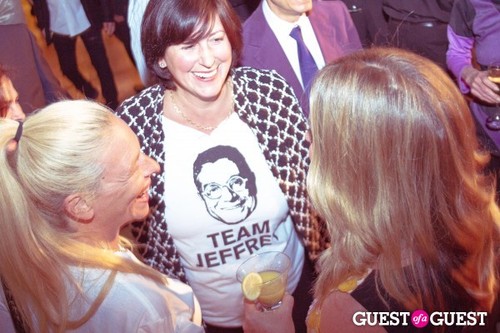
WWD continues
Apparently an anonymous donor sent a box of the shirts over to MOCA in support of the embattled museum director. Deitch even posed with women wearing them in front of the giant plaster Baguette in the courtyard.
Apparently. So much journalism embedded in that single word. Did these women get their shirts from MOCA? Did someone from MOCA bring a stack of shirts to hand out at someone else’s event?
To answer these exciting questions, I looked through several hundred images from Baguettemania, and it appears Mrs. Taschen was the only member of Team Jeffrey to be rocking this particular look. I can’t guess where WWD might have gotten that report.
Instagram Update: I have learned the Team Jeffrey shirt was discussed in the social media coverage of Baguettemania, and that Deitch cheerily said the shirts were made by “a street artist” as a gift. Which is very thoughtful. And also gives us a chance to reflect on the difference between anonymous and unleaked.
INSIDE Maxfield + Fendi’s Baguettemania with Jeffrey Deitch, Mena Suvari & James Goldstein [guestofaguest, thanks @theodoreart]
See this and four pages full of other images by Filip Milenkovic from Baguettemania at Guest Of A Guest! [guestofaguest.com]
One Song More
Wow, is it that time of Election Year already? When superblogger and apparently self-hating theater queen Andrew [Lloyd] Sullivan posts a WTF Obamafied version of a Les Mis anthem?
This time it’s “One Term More” which, Holy Cameron Mackintosh, people. Just go watch it this very instant. Don DeMesquita, ladies and gentlemen.
Because it even has “A Political Parody” right in the subtitle, I’m forced to wonder what, exactly, it’s a parody of. And then how do I really know it isn’t some kind of super-jiujitsu triangulating GOP countermeasure to psych out musical theater liberals? But no, the fair use disclaimer is so desperate, they must be real.
HOW COULD I HAVE EVER DOUBTED UPDATE: I forgot the couplet, “Emboldened by Star-Spangled myth,
We want a JEDI…NOT a SITH!!!”
Anyway, in 2008, it was “Les Misbarack,” UltimateImprov’s straight-up lipsynch of “One Day More,” set in the Obama National Campaign HQ on election eve.
Which Sullivan introduced on Sept. 12th, at 4:53 AM, with the comment, “Whatever happens, the McCain campaign could never pull this off. Patience, steel… triumph.”
To which I will only add, “Malgre tout, la Resistance demeure.” Or in this case, “So hat doch, la Resistance gesiegt!”
La Pauvrette By Chaim Soutine
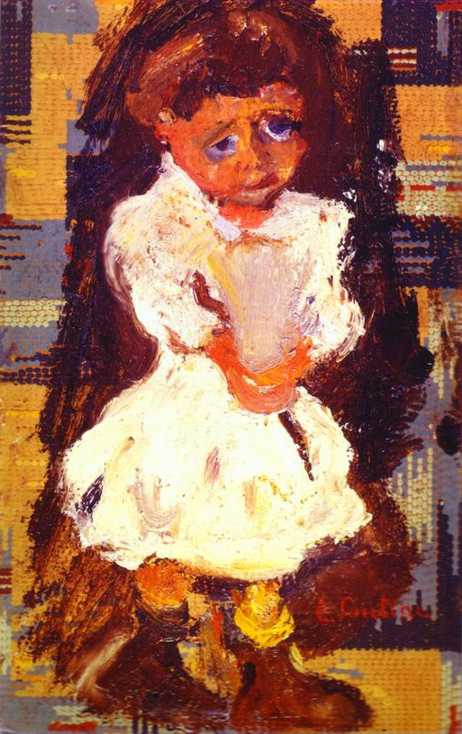
Ooh, I’ve been going through boxes of books in storage, and there have been some great finds. [And also some total crap books that, what, I have no idea, except that at one point in my life it was apparently impossible for me to leave Rizzoli emptyhanded.]
On the bright side, there was also Maurice Tuchman’s original 2-vol catalogue raisonne for Chaim Soutine, published in 1993, which I don’t think I’ve opened for 15 years. It’s so fantastic. Full-page, full-color illustrations for almost every work [of course, the Barnes’s Soutines are reproduced in black & white.]
One painting I’ve never seen in person, and hadn’t noticed before, is this late [c. 1934 or 1937] Portrait of a Small Child, also known as La Pauvrette. [The artist told Max Kaganovitch, the dealer who bought it in 1937, that she was embarrassed by her worn out shoes. He always painted from life, too, so I’m willing to believe he didn’t just imagine this.]
What caught my eye this time–besides the kid’s eyes, which, right??–was the abstract gridded dot pattern in the background. As if Soutine painted the girl on top of an Alma Thomas, or this was part of his geometric pointillism period, which, given his manic, spontaneous expressionism, would make him even more disturbing.
But it turns out to be linoleum. For whatever reason, I can’t figure out, but maybe it was Soutine’s perennial poverty, he painted this on a 9.5 x 15-inch piece of linoleum flooring.
Though he occasionally painted on wood, or on canvas mounted to a board, this is the only known painting Soutine did on linoleum. Kaganovitch wrote that upon purchasing the piece, the artist initially wanted to “finish” it by painting out the patterns, but he decided to leave it. Which seems unprecedented.
In 2006, Kaganovitch’s heirs sold La Pauvrette at Sotheby’s in London for around 388,000 pounds. So on the bright side, it’s not in a museum, which means it is now on my to-buy list. On the other hand, to clear that list, I will need a billion dollars.
20 Jun 2006, Lot 457: LA PAUVRETTE, est. GBP 150,000-200,00 [sothebys]
‘Domestic Objects’ Opens Tonight, Sept 5 @ Bridge Gallery
And speaking of art and politics….
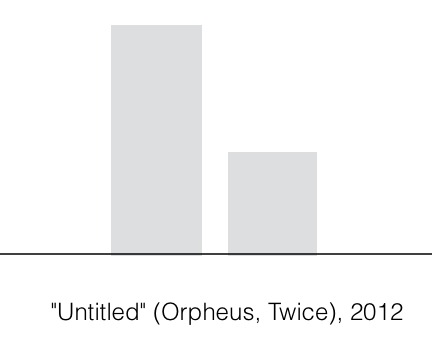
I am stoked to announce my participation in “Domestic Objects,” at Bridge Gallery on the Lower East Side. The show opens tonight, Wednesday, September 5th, and runs through October 18.
In addition to my piece, the show includes work by John Powers, Susanna Starr, and Jer Thorp & Diane Thorp. “Domestic Objects explores concepts of our constructed private spaces, belonging, family, domesticity, and material possessions.”
Which seemed to me like an excellent context and time for “Untitled” (Orpheus, Twice), 2012. It’s a piece I’ve actually been thinking about for a couple of years, but this is the first time it will be installed.
I’ve been thinking about art that doesn’t exist, and why not. “Untitled” (Orpheus, Twice), 2012, is a speculation, or a wistful reimagining, of Felix Gonzalez-Torres’ 1991 work of the same title. I’ll probably write more about it later, and how it came to be, but now I’m going to hit the road.
If you’re able to make the opening tonight, it’d be great. Otherwise, I hope you’ll get to see the show while it’s up.
Domestic Objects, 5 Sept – 18 Oct, Bridge Gallery, 98 Orchard St (Del/Ess) [bridgegalleryny.com]

